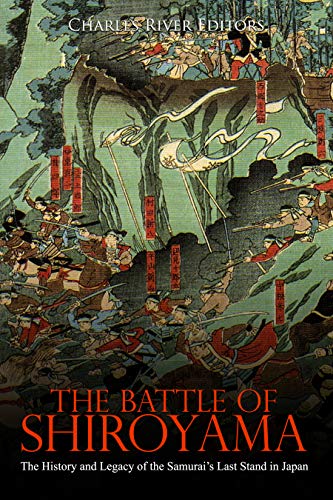The Battle of Shiroyama: The History and Legacy of the Samurai’s Last Stand in Japan
*Includes pictures*Includes excerpts of contemporary accounts*Includes a bibliography for further reading*Includes a table of contents On September 25, 1877, on a rain-soaked, muddy field in Kagoshima, Japan, a small group of proud samurai warrior rebels prepared for one last stand. It was early morning, 6:00 a.m., and the remaining 40 samurai warriors still capable of
*Includes pictures
*Includes excerpts of contemporary accounts
*Includes a bibliography for further reading
*Includes a table of contents
On September 25, 1877, on a rain-soaked, muddy field in Kagoshima, Japan, a small group of proud samurai warrior rebels prepared for one last stand. It was early morning, 6:00 a.m., and the remaining 40 samurai warriors still capable of fighting prepared themselves for the glory of death on the battlefield. They had been shelled by powerful artillery guns and naval cannons relentlessly through the night, and the rebels had no real shelter or protection. Instead, they cowered like rats in small, rain-filled mud holes, showered by a torrent of steel shells and shrapnel.
For seven months, the samurai rebels had fought a losing battle against the army of Emperor Meiji, the new ruler of Japan’s central government. It was a modern army, filled with conscripts, armed with rifles, and trained in European tactics. The samurai rebels were also armed with rifles, but months of fighting had stripped them of ammunition. They still possessed their distinctive personal weapons – their katana swords – and they intended to use them one last time.
Despite the overwhelming firepower and numbers advantage wielded by the central government, the rebels, led by Saigō Takamori, a samurai warrior and proud defender of the samurai tradition, remained stoic in their final moments. By early morning, the last capable samurai drew their swords and launched a final suicidal charge into the rapidly firing rifles of 30,000 conscript troops, members of Japan’s modern imperial army. It would be the samurai’s last stand.
Lionized in the Tom Cruise film The Last Samurai, the Battle of Shiroyama was the dying gasp of feudal Japan. For centuries, the Japanese warrior caste, known as the samurai, had held positions of high prestige and privilege in Japan. Paid a stipend and holding both military and civil positions, the samurai were a proud group that looked down upon Japan’s commoners and merchants. They served the Tokugawa shogunate, a military dictatorship that ascended to power and isolated Japan from the rest of the world, for more than two centuries, ending a period of constant civil war.
This blissful isolation changed with the arrival of American Commodore Matthew Perry in 1853. In awe of the American weapons and ships, the Tokugawa shogunate quickly realized that they needed to evolve and modernize their military to survive, and a time of rapid change descended on Japan. Within a mere 30 years, the Tokugawa period’s great samurai caste was extinct. Military service was no longer the exclusive domain of the privileged warrior class who had combined the military with an intricate network of social status and vassalship to their feudal lords. For the new Meiji government of Japan, military conscription was an obligation for all able-bodied men. The social castes that had existed for centuries, including the samurai, commoners, and outcasts, were replaced by a new system of national subjecthood that would propel Japan into the modern era. One group of samurai dreaded these developments, which threatened their very existence, and they launched a rebellion under the legendary samurai Saigō Takamori. Japan descended into a civil war lasting seven bloody months, culminating with the battle that brought about the end of the samurai.
The Battle of Shiroyama: The History and Legacy of the Samurai’s Last Stand in Japan chronicles the events that brought about the rebellion, the dramatic battle, and the aftermath. Along with pictures depicting important people, places, and events, you will learn about the Battle of Shiroyama like never before.
Bestsellers 2021
Auto Amazon Links: No products found.







Comments
Comments are disabled for this post.